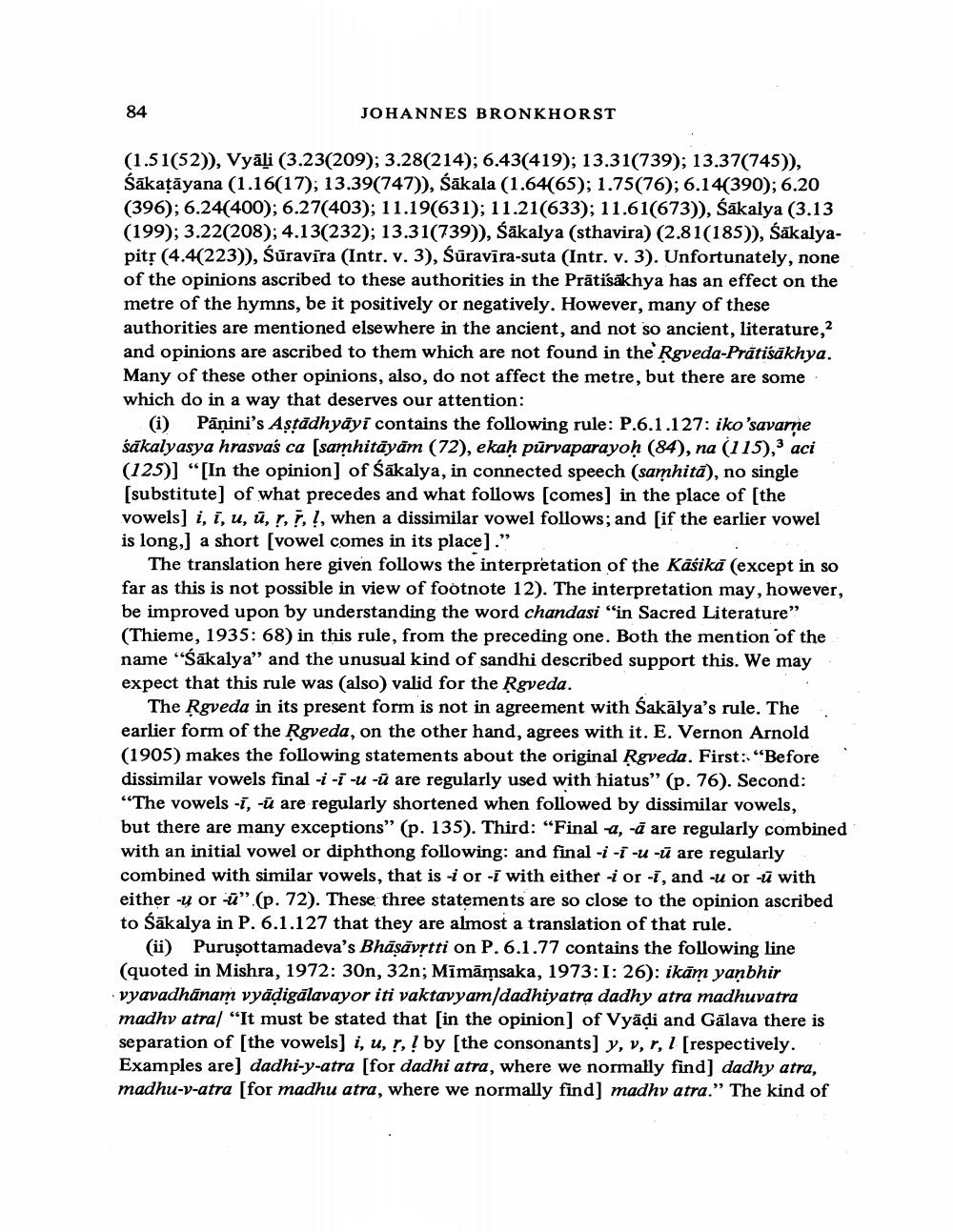________________
84
JOHANNES BRONKHORST
(1.51(52)), Vyāli (3.23(209); 3.28(214); 6.43(419); 13.31(739); 13.37(745)), Sākațāyana (1.16(17); 13.39(747)), Śākala (1.64(65); 1.75(76); 6.14(390); 6.20 (396); 6.24(400); 6.27(403); 11.19(631); 11.21(633); 11.61(673)), Śākalya (3.13 (199); 3.22(208); 4.13(232); 13.31(739)), Śākalya (sthavira) (2.81(185)), sākalyapit? (4.4(223)), Śūravīra (Intr. v. 3), Śūravīra-suta (Intr. v. 3). Unfortunately, none of the opinions ascribed to these authorities in the Prātiśākhya has an effect on the metre of the hymns, be it positively or negatively. However, many of these authorities are mentioned elsewhere in the ancient, and not so ancient, literature, and opinions are ascribed to them which are not found in the Rgveda-Prātiśākhya. Many of these other opinions, also, do not affect the metre, but there are some which do in a way that deserves our attention:
(i) Pāņini's Astādhyāyi contains the following rule: P.6.1.127: iko'savarne śākalyasya hrasvaś ca (samhitāyām (72), ekah pūrvaparayoh (84), na (115), aci (125)] “[In the opinion) of Śākalya, in connected speech (samhitā), no single (substitute] of what precedes and what follows (comes) in the place of the vowels) i, i, u, ū, ?, ?, !, when a dissimilar vowel follows; and (if the earlier vowel is long,] a short (vowel comes in its place]."
The translation here given follows the interpretation of the Kašikā (except in so far as this is not possible in view of footnote 12). The interpretation may, however, be improved upon by understanding the word chandasi "in Sacred Literature" (Thieme, 1935: 68) in this rule, from the preceding one. Both the mention of the name "Śākalya" and the unusual kind of sandhi described support this. We may. expect that this rule was (also) valid for the Rgveda.
The Rgveda in its present form is not in agreement with Sakālya's rule. The earlier form of the Rgveda, on the other hand, agrees with it. E. Vernon Arnold (1905) makes the following statements about the original Rgveda. First: “Before dissimilar vowels final -i -i -u -ū are regularly used with hiatus" (p. 76). Second: “The vowels -i, -ū are regularly shortened when followed by dissimilar vowels, but there are many exceptions" (p. 135). Third: “Final -a, -ă are regularly combined with an initial vowel or diphthong following: and final -2 -1 -u -ū are regularly combined with similar vowels, that is-i or -1 with either - or -7, and -u or ū with either -y or ū” (p. 72). These three statements are so close to the opinion ascribed to Śākalya in P. 6.1.127 that they are almost a translation of that rule.
(ii) Puruşottamadeva's Bhāṣāvrtti on P.6.1.77 contains the following line (quoted in Mishra, 1972: 30n, 32n; Mīmāmsaka, 1973:1:26): ikām yanbhir vyavadhānam vyādigālavayor iti vaktavyam/dadhiyatra dadhy atra madhuvatra madhv atra/ "It must be stated that in the opinion) of Vyādi and Gālava there is separation of [the vowels] i, u, ?, ? by [the consonants) y, v, r, 7 [respectively. Examples are] dadhi-y-atra [for dadhi atra, where we normally find) dadhy atra, madhu-v-atra [for madhu atra, where we normally find) madhv atra." The kind of




